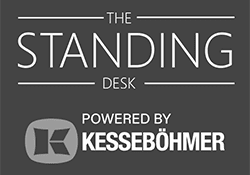
Everything to Know About Standing Desks
This is a guide and an introduction to standing desks. Why have they grown in popularity, what are the benefits of an adjustable desk, what stand up desk options are out there, and what do you need to know before buying and using a sit and stand desk??
Why do people use standing desks?
Once an office novelty, standing desks are taking over our workplaces and home offices. For some people, an adjustable desk is the best way to add movement to a long work day. For others, they reduce discomfort of sitting all day, or allow flexibility to perform different types of work. Particularly for people who suffer from lower back or neck pain, having the ability to adjust positions can help alleviate the discomfort.
That said, there are plenty of people who do not want to stand at work, or certainly not all the time. Standing all the time can result in stress injuries or vascular issues. The sweet spot is generally somewhere in the middle – standing occasionally, with opportunities to sit and vary posture as well.
What types of standing desks are there?
Standing desks have likely been around almost as long as any other kind, with famous historical thinkers like Thomas Jefferson known to prefer them. Currently there are a few main stand up desk options.
Fixed height standing desks
Fixed standing desks don’t move, so people who want to do all of their desk work while standing often choose this style. Fixed height desks are generally wallet friendly, and can be attractive in their minimalist design. If you don’t use your desk that often during the day because you’re moving around a lot, you may always want it in the standing position. However, fixed height desks lack one of the key advantages of height adjustable desk – to the flexibility to change postures at will.
Sit to stand desks
Straddling the category of traditional sitting desk and fixed standing desk, we have the sit-stand variety. In order to look at sit stand desk pros and cons, we have to keep in mind that sit-stand desks come in a few different styles, each with its own strengths.
- Electric standing desks provide controlled, powered assistance to raise and lower the work surface. An electric adjustable desk can have high lifting capacity, if you have a place to plug it in and actually need to lift 200+ lbs of computers and accessories.
- Manually adjustable standing desks come at a lower price point than other types. Their adjustment mechanism may negate some standing desk ergonomics benefits and usage if the manual cranking mechanism is cumbersome and slow.
- Pneumatic standing desks raise and lower the work surface smoothly with cylinders powered by air. Pneumatic desk adjustment tends to be smooth, quiet, and speedy.
- Hydraulic standing desks use fluid to achieve mechanical power. A hydraulic standing desk generally requires electricity and has the potential to leak oil, but this type can lift some of the heaviest loads.
- Sit to stand desk converters can be attached to a traditional desk to allow it to function as a stand up computer desk as well. For people who already have a traditional desk and don’t want to swap it out, the standing desk converter is a way to adapt to a sit-and-stand work day. Some converters can be a more portable standing desk. However, it can be harder to make these adapters ideal in terms of appearance and useful space. And for shorter users, converters severely limit the ability to achieve an ideal ergonomic position.
For people who are on the fence about adopting a standing desk vs sitting, one of these sit and stand desk models can provide a middle ground.
Desks for exercise equipment
Although standing itself is no substitute for actual exercise, a sit stand workstation can be used with other accessories to burn more calories or ramp up fitness while working. Some types of fitness equipment that can boost your fitness include balance boards that you use while standing to increase core muscle strength, or balance balls to do the same while sitting.
- Desks for use with treadmills: Treadmill desks are available as an all-in-one option, or as a regular height adjustable desk paired with an office treadmill. Either option can help burn calories, but integrated options often include ergonomic features that make it easier to work while walking, like adjustable keyboard trays to assist with stability.
- Desks for use with exercise bikes: Some standing desks are designed especially for use with exercise bikes, with features like a crossbar for balance. These can be used with a bike-and-chair combination. There are also fully integrated bike desks that combine bike, chair, and desk.
What materials are standing desks made from?
Materials define the overall style of the standing desk as well as its durability. The materials of construction have a lot to do with whether the desk will last a year or hold up to daily use for decades to come.
Standing desk leg materials range from steel to wood to polymer plastic. Work surfaces can be made from solid hardwoods like walnut, soft sustainable woods like bamboo, plastics, or laminated substrates. For production workshops or for a completely industrial look, some manufacturers offer a stainless steel standing desk. In most cases, the strength of stainless steel is reserved for the desk legs, which may be powder coated to achieve different colors and textures, but specialized desks that are constructed entirely of metal are used in production workshops.
Due to offshoring in the furniture industry in recent decades, standing desks made in the USA are harder to find than those made elsewhere. Some American made standing desks source materials from different countries of origin for an even higher quality end product.
When did standing desks start to become more popular?
Although standing desks have been around the workplace for a long time, the popularity of the standing work desk has really occurred within the last decade. In 2014, only 20% of employers offered a sit stand desk as an option, according to the Society for Human Resource Management. According to the latest SHRM survey in 2019, that figure had increased to 60%. Many organizations have followed Google’s lead and even reimburse employee expenses for a home office standing desk.
If you look around the workplace and see only a few standing desks, you may wonder – do you need a doctor’s note to get a standing desk? In some organizations, a doctor’s note is required, but before you call to schedule an appointment, the HR department is the place to start. Your company may already have a policy in place for requesting a standing desk. As standing desks have become more mainstream, it’s increasingly common to be able to request a standing desk from your department head or from HR directly.
Indeed, since standing desks have become more standard, more types of employers are asking the question “Should you offer standing desks to employees?” Although not everyone will request one, standing desks have been one of the most popular wellness benefits among employees in recent years. Their direct impact on employee health appears to be modest, but they do generally increase individual comfort.
What is an electric standing desk?
Some of the first stand up computer desk models involved hand crank mechanisms that made slow adjustments. The electric adjustable desk was one of the first to answer the need for smooth, fast adjustments and powered lifting assistance. Although an electric height adjustable desk requires a cord and a source of power, even a small standing desk can lift large loads. And a large stand up desk with powered assistance can offer enough weight capacity for a desktop computer, a few monitors, and more.
What industries or professions benefit the most from standing desks?
Any desk based work can adapt to an adjustable desk. A standing desk is a common perk in tech industries, led by Google (which offers them as part of its wellness program), Facebook, Apple, and various Silicon Valley companies. Other tech workers, including web designers, software developers, and the like are some of the earliest adopters of a stand up computer desk.
Creative workers like artists, architects, designers, and product designers who work collaboratively also see adaptability as one of the stand up desk advantages.
Other workers who can work most comfortably with a sit stand desk include:
- Writers and editors
- Finance, marketing, account management, PR, and sales
- Business consultants and recruiters
- Accountants and clerical staff
- Retail staff
- Receptionists, office managers, and directors
- Students and teachers
A home office standing desk is an increasingly common sight, as the number of home office setups – whether a separate room or a separate corner – has ballooned. Many of these models designed as a standing desk for small spaces.
Are standing desks as strong as other computer desks?
Standing desks convey a lighter, more contemporary look than many of their traditional counterparts, so it’s common to wonder whether they hold up to the day to day requirements. It’s not hard to imagine a cheap desk giving in to the weight of huge load, especially if there is movement involved. Any standing desk model should have a recommended weight capacity, so pay attention to the rating of the desk. Luckily, the furniture industry has a regulating body, Business Institutional Manufacturers’ Association (BIFMA), and some of the strongest standing desks have been tested to ANSI/BIFMA X5.5 standards.
How much weight can standing desks hold? There is a lot of variation between standing desk models and manufacturers. For most office work, the weight of a few papers and books, a laptop, a monitor, and some other gadgets and office supplies adds up to less than 15 lbs. So for most people, a well made standing desk of any type should work just fine. If the desk will need to lift heavier objects like 3-4 monitors and a desktop computer or a very heavy solid wood work surface, you’ll want something a little sturdier to help lift all that weight, like pneumatic height-adjustable desk.
How many monitors can standing desks hold? Most monitors don’t actually weigh much more than 5 lbs., or a maximum of 10. Checking the weight capacity of a desk is a good idea, but most quality models that have enough surface area to fit multiple monitors will be able to support their weight. (Monitors do require a certain amount of space, so a large stand up desk is needed.) The primary concern with multiple monitors is that the movement mechanism should be smooth enough to prevent wobble as the desk is raised and lowered.
The Recken Desk
Now Only $599
Experience the Strong, Safe & Intelligent Recken Standing Desk
Shop The ReckenHow do you use a standing desk?
These tips can help maximize the benefit of a standing desk.
- Choosing the right height setting. Finding the sweet spot for an adjustable desk – both seated and standing – requires some fine tuning. For the most ergonomic experience, check out our stand up desk height adjustment tips.
- Standing desk posture. When standing, make sure your head, neck, and legs are approximately in line. An ergonomic analysis can help fine tune your desk and posture.
- Padded anti-fatigue mats. Anti-fatigue mats are an easy upgrade that enables most people to stand comfortably for longer periods, and may even encourage more movement. Be sure to factor in the thickness of the mat and the shoes you wear when adjusting your optimal desk height.
- Balancing standing and sitting time. Aim for a regular schedule that alternates sitting and standing. Some people find that timers work well, while others choose to vary their posture based on what activities they’re doing, like answering email while standing and writing reports while sitting.
Choosing the right standing desk for you
Desk work comes in all shapes and sizes – and so do desk workers. Finding the right standing desk means considering your body, your habits, and the type of work you do. Work that involves collaboration, or a lot of reading, or just a lot of manual work may lend itself well to a sit stand desk.
When narrowing down how to choose standing desk options, keep in mind a few key priorities:
Height & dimensions – The optimal desk height for a sitting desk is generally 28-30”, but there is considerably more variability in standing desk dimensions. If you’re above or below average height, check the ideal stand up desk height to make sure the desk can accommodate your ideal range of adjustment.
Surface area – When considering how much surface area you need, keep in mind the space available in your office, because the footprint of your desk makes a difference. For multiple monitors, desks up to 30”x60” or larger provide ample space. A small standing desk, on the other hand may measure 24”x40” – enough to hold a laptop and monitor and other office supplies, but small enough to tuck into cozier spaces.
Weight limit – Think about the items you expect to have on the desktop, and come up with a rough estimate of the weight your standing desk will need to support. A standing desk converter will tend to have the lowest weight limits, so the calculation becomes more important. In general, though, a light laptop and monitor actually weigh only about 15 lbs., so weight capacity can be a small factor.
Ease of use – Some standing desk models are clearly designed with the user in mind. The adjustment mechanism – whether a crank, a lever, or a switch – can be a game changer in how often you end up adjusting your stand up desk height. A motorized standing desk can help do some of the heavy lifting. Beyond that, ease of use is largely related to standing desk ergonomics – whether the desk can be easily and comfortably adapted to the person who will be using it.
Appearance – Standing desks do vary in style, so if you don’t like the look of one, keep looking. Some appear institutional, while others have a minimalist aesthetic. Some are offered in a range of surface and frame colors to coordinate with your space.
Accessories – A number of accessories on the market can elevate your standing desk experience. Consider a monitor arm to fine tune your monitor’s height. A cable management system can enhance safety and reduce cord clutter for an electric height adjustable desk – or any other desk that holds electronics. A padded anti-fatigue mat can make standing time more comfortable. Casters can help make a more portable standing desk.
Quality materials & construction – The craftsmanship of the desk determines whether it will have the durability to last for years. Choose a sturdy desk that has a smooth adjustment for the weight you expect to place on the surface.
Want to know more? Reach out. We’d love to hear from you.






